Ballast?
|
Does anyone use ballast. I know some of the Oughtred designs use up to 50 kg for single handed sailing, and some Ilur skippers use 30- 50 kg.
(We might even get a sail this weekend (29/7), forecast is for 5-15 knots instead of the usual zero or gale force.) |
|
Administrator
|
You've made me wonder whether I should ballast when solo.
A friend uses water ballast to apparent good effect when solo in a Goat Island Skiff. Several Morbics are sailed solo so it will be interesting to hear other comment. It would seem viable to experiment with water containers lashed to the limber holes in frame 3, i.e. alongside the centre-plate casing. Maybe it would allow me shake out a reef or two and perhaps go faster. For reference – PW capsized only once (and dry at that!). Causes; over confidence; lack of experience (a couple of years back); using jib and full mainsail; then getting mainsheet snagged. My weight is currently around 60kg. Never used ballast, unless you count human - sometimes aboard. Solo sailing has only been on the lake. Highest wind was 35-ish gusting 40-ish (knots) according to Wunderground. Solo, fully reefed, no jib (mast in forward position – "Proteus can change his shape …."). |
|
Just for comparison;
I know some very experienced sailors who have sold their Goat Island Skiffs because they found them a bit scary. Big Rig high performance, think Laser but without the built-in buoyancy. Th Morbic12 is a different beast. I sail solo mainly with just the balanced lug rig. I tend to reef early and often too much leading to being under powered at times. I need to toughen up and sail the boat properly. Haven't felt the need for extra ballast, if it's that windy I'm not going out.
Graham Neil
https://port-na-storm.blogspot.com/
|
|
In reply to this post by Nigel McC
Hello everyone.
I haven't built my Morbic yet - or even sailed in one - but based on my experience of sailing quite a few different lightweight dinghies over the years, I would comment: - addition of a modest amount of internal ballast to a hull like the Morbic 12 will probably slow the movement of the boat down somewhat, which has some value for comfort and safety I guess. It will give you a bit of extra time to react. - If I look at the effect of a lightweight crew in a boat like the Mirror - say a 40 or 50kg junior sailor - sitting in the centre of the thwart, with the skipper sitting in or out, according to the base wind strength: when a strong gust hits, the junior's weight will slow things down a bit and make the boat a little less likely to capsize; but it's mainly the amount of sail that you are carrying - and whether you spill any of its force - that will decide if the boat will go over or not. Even the Mirror's 49 square foot mainsail and 20 square foot jib is enough to put the boat over if it's the wrong amount of sail to be carrying. On the other hand, once you have tied in a reef, you and your crew will have to work hard to end up in the water. I guess it really depends on what you are trying to achieve with ballast. I think you would need to put a large amount of internal ballast into a Morbic 12 to make it significantly less likely to capsize. And that would change the nature of the boat a lot. - For my part, I think I will concentrate on getting my reefing (and shaking out) routines going well. If I feel any temptation to add ballast, I think I would go for just 10 or 12kg in the centreboard, and that would only be to assist with righting the boat after capsizing. Bear in mind that I may entirely change my mind after sailing the boat! Regards Hugh, from windy Wellington. |
|
Yes, good points. Ballast has two effects. First to lower the centre of gravity and hence reduce risk of capsize. For that purpose, the ballast can be sited either side of the centre case. But the second is to change the weight distribution. If you look at photographs of solo sailers, the weight is frequently too far back, because the helm is sitting aft, hence the bow is up. Adding ballast at the bow changes the lateral weight distribution hence the water line length and sailing characteristics.
I've made a couple of ballast bags, I'll fill them with sand next time I go out, and see what happens:) |
|
Hello Nigel. Yes, you see a lot of photos on the web of solo sailors sitting too far back in their boats. In a (comparatively) light boat like the Morbic 12, I expect sitting too far aft would cause problems with helm balance, quite apart from slowing the boat down (at displacement speeds). I've seen quite a few photos of Morbic 12's without a tiller extension - or with a short extension - which would make it very difficult to be positioned correctly when sailing solo with no additional gear on board.
|
|
Administrator
|
Fore-&-aft trim + Tiller extensions.
When sailing lasers, an instructor often reminded me to sit further forward to keep the boat longitudinally horizontal. Maybe someone will confirm that the main purpose would be to keep the waterline length Vs beam ratio as high as possible - Long thin boat goes faster than short fat one. i.e. bows-up slows the boat. So, sitting out &/or sitting forward is required especially if sailing solo, but most tiller extensions are an unsightly invention of the devil, not compatible with your beautiful Morbic. What can be done about it? - "Proteus" has a slight weather helm tendency, so experiments with a bit of string evolved into a Morbic-worthy solution. 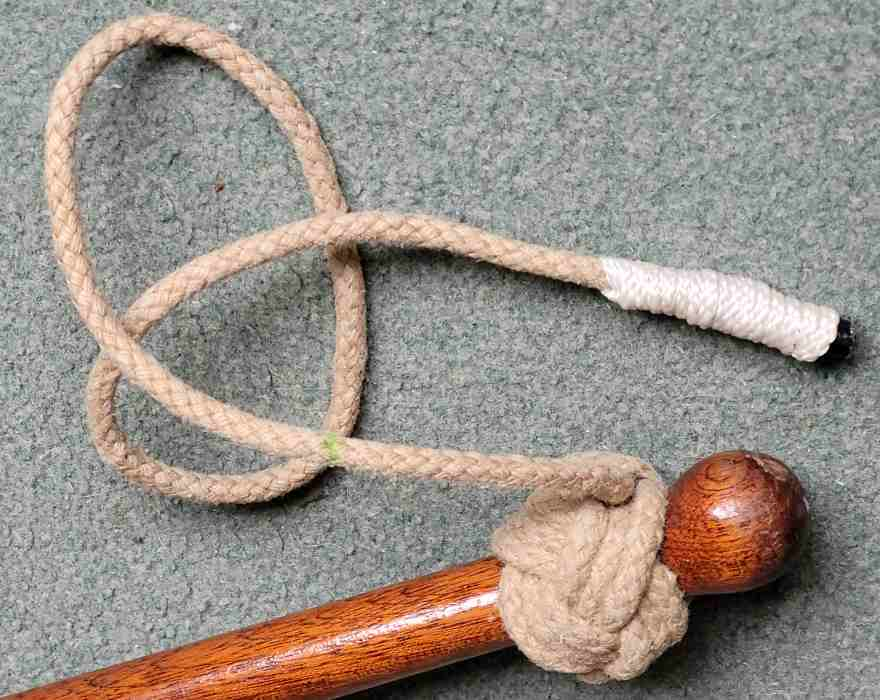 Soft tiller extension for Morbic 12. When not required it dangles just clear of the deck. It must be long enough to be useful but not so long as to touch the deck - Treading on it could be troublesome. The thickened end prevents slipping through your fingers. The Turk's head is optional. A little light tension keeps you sailing straight; releasing lets you head up. What more could you want? Try it. It also comes in handy when you want to lash the tiller. You can't do that with one of those telescopic folding thingys! (PW wonders - Will tiller extensions deserve their own thread? And has anyone got any thoughts about tiller tamers for Morbics?) |
|
Hi Paul.
From what I have gathered over the years - from experience, listening and reading - sitting too far aft in most light dinghies induces lee helm, which I would never like to have. Boats do best when they are sitting on or close to their designed water line. To achieve this on a Morbic 12, I would imagine a solo sailor would need to be sitting quite close to the thwart. I personally don't feel a nicely made tiller extension is offensive, and I wouldn't like to sail an unballasted dinghy in any sort of wind/seaway without an extension. I think many sailors are quite used to tacking and gybing with an extension, and would find a rope extension less useful. All this is of course down to our individual preferences, and one sailor's way of skinning the cat won't necessarily work for another. Cheers Hugh |
|
In reply to this post by PaulW
My take on the boat trim issue is to make an extension
in keeping with the Morbic character. It is not too long and has a rest position using a brass stub on the tiller and mating hole in the extension. 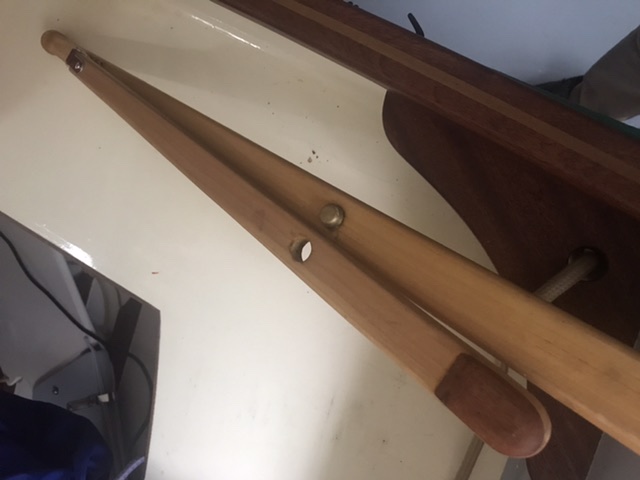 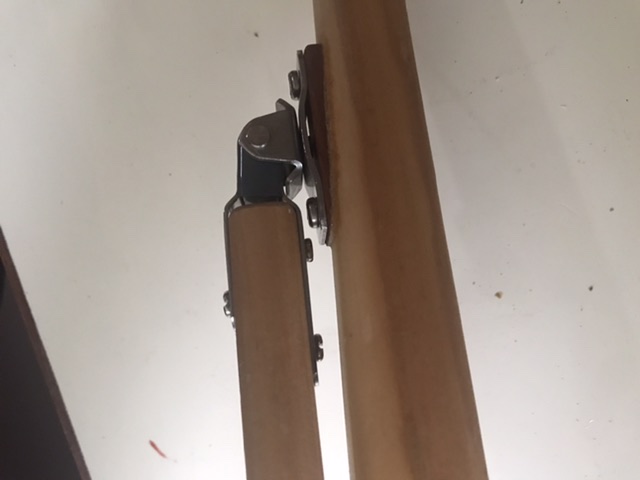
|
|
Nice job!
|
|
Administrator
|
Yes Peter looks decent - Well done. Is it curved to match the tiller?
(I'll look forward to seeing it in about 10 days.) PW |
|
In reply to this post by Peter Taylor
I do like an extension. I built two tillers, one with, and one without an extension, but they are not nearly as good looking as Peter's.
On trim, I do remember from my laser sailing days (long ago), that one training exercises was to sail the boat round a short course without a rudder, using just position and lean. It was very interesting, and if you watch the gun sailers, they shift forward and aft to adjust helm. I think an extension is almost essential on any dinghy, otherwise the helm is restricted aft, and trim limited. |
|
Hi, I have not finished mine so it is not tried out yet but I’m trying to make one that is not very different from the boat style:
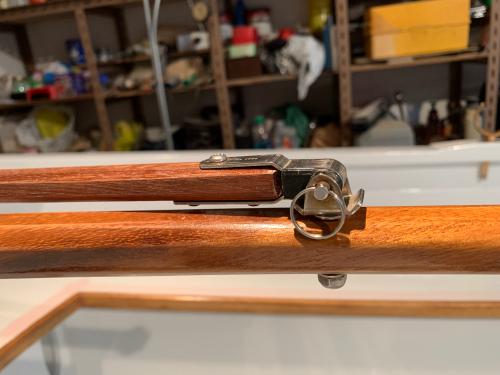 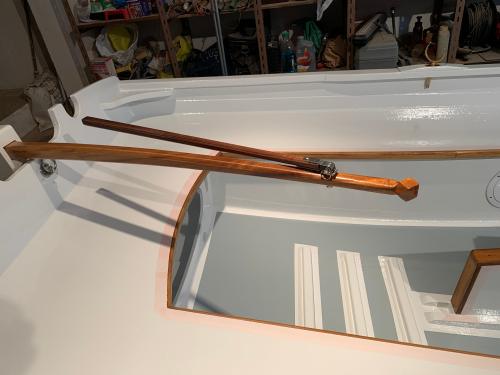 It is a little tapered and the idea is to make a turks head close to the top of the extension stick. Anyway I have to admit that I like the mix of styles: I will be using dyneema ropes and harken blocks and cleats on this traditional styled boat: 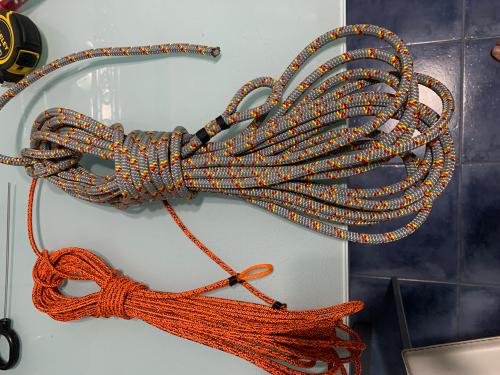 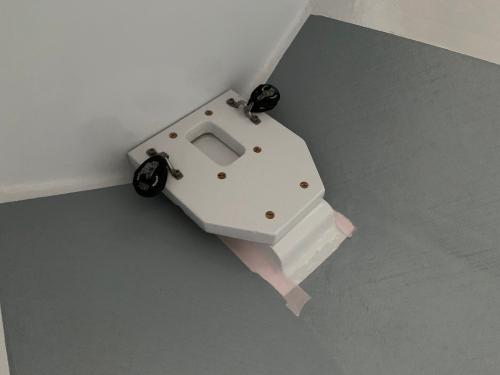 I have modified the mast base to have both lines reeved aft to two cleats under the central thwart. By the way I have a 4kg ROCNA with 4 m of 6 mm galvanized chain and 34 m of 8 mm rope. The chain is useful not only to keep the pulling angle low but also to protect from rubbing against rocks and other sharp objects. Best regards, Carlos Herrán |
«
Return to MyMorbic Sail-&-Oar Dinghy UK Network
|
1 view|%1 views
| Free forum by Nabble | Edit this page |

